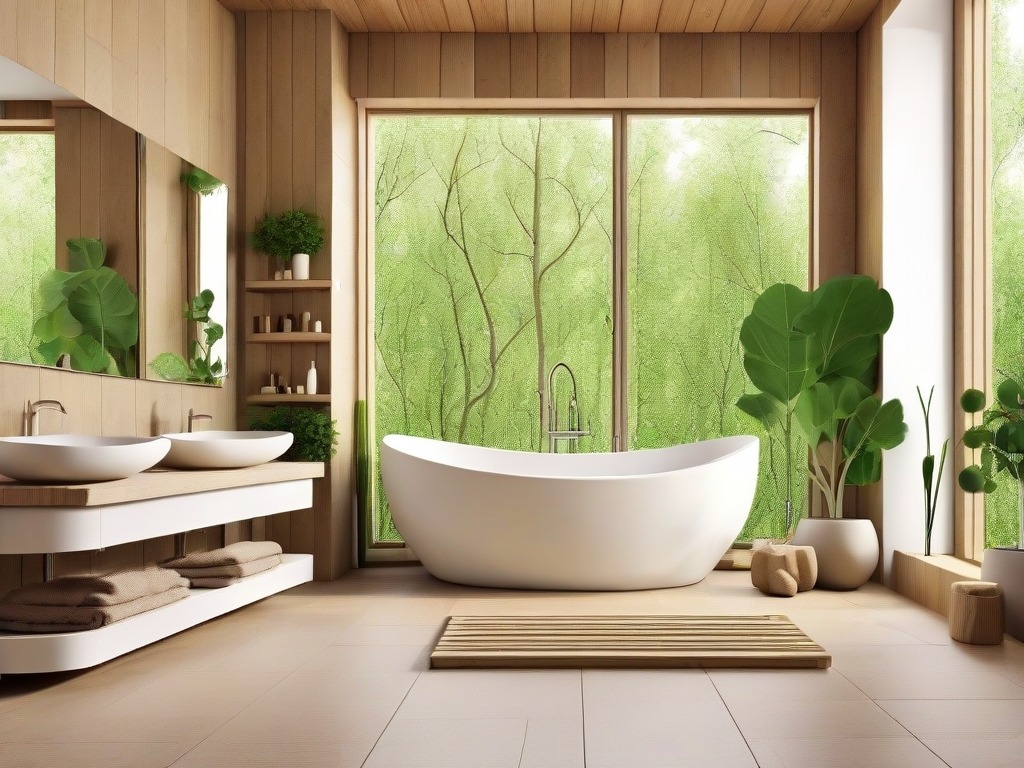
In today’s rapidly evolving world, where sustainability is more than just a trend but a necessity, the bathroom—a space often overlooked in eco-friendly bathroom materials considerations—presents an incredible opportunity for transformation.
Imagine stepping into a sanctuary that not only uplifts your spirit but also nurtures the planet. By opting for eco-friendly materials in your bathroom, you can create an oasis of relaxation while actively participating in responsible consumption.
Your choice of tiles, fixtures, and textiles can significantly lessen your home’s ecological footprint, paving the way for healthier lifestyles and cleaner environments.
The benefits of integrating sustainable materials go beyond aesthetics; they represent a powerful movement towards conscientious living.
Homeowners stand to gain longer-lasting, durable items that contribute to reduced waste and energy conservation while aligning with modern sensibilities of style and comfort.
As we explore innovative options—from bamboo flooring to reclaimed wood accents—you’ll discover how easy it is to embrace this ethos without sacrificing design or functionality.
Join us on this journey as we unveil eco-friendly bathroom materials that will inspire you not just to renovate your space but also to foster meaningful change within yourself and the wider community. Ready to dive in? Your green bathroom revolution starts here!
Sustainable Flooring Options
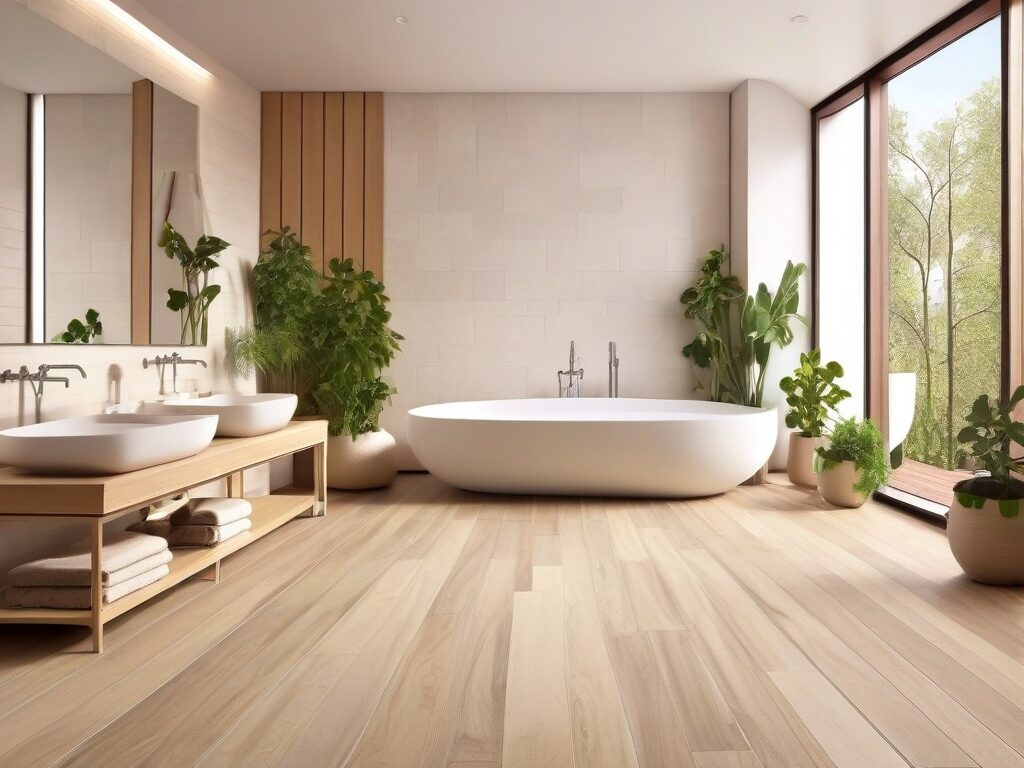
When considering eco-friendly flooring for your bathroom, bamboo emerges as a top contender. While traditional hardwoods take decades to mature, bamboo can be harvested in just three to five years, making it a highly renewable resource.
Its unique resilience offers homeowners not only an aesthetic option but also durability; bamboo is about 25% harder than oak! Available in various colors and styles, from rich caramel hues to lighter natural finishes, this flooring choice allows you to create a tranquil retreat reminiscent of nature’s beauty while promoting sustainable living.
Recycled tiles provide another fantastic flooring alternative that combines sustainability with style. Manufacturers are now creating elegant tiles from repurposed materials such as glass, porcelain, and ceramic—transforming waste into stunning visuals.
For instance, imagine selecting bright mosaic tiles made from recycled bottles or bold geometric designs crafted from salvaged ceramics. Not only do these tiles reduce landfill waste, but they also allow you to express your personality through distinctive patterns that enhance the overall ambiance of your bathing space.
Lastly, cork flooring offers a blend of comfort and environmental consciousness often overlooked by homeowners. Derived from the bark of cork oak trees—which naturally regenerate after harvesting—cork is both eco-friendly and unique in its insulating properties.
It provides warmth underfoot while maintaining sound absorption to create a peaceful bathroom environment. Furthermore, its natural resistance to mold and mildew makes cork an excellent choice for humid areas like bathrooms; you won’t just be investing in beautiful flooring but also fostering wellness in your home.
Incorporating one or more of these sustainable flooring options into your bathroom design not only reflects your commitment to the planet but also adds character and tranquility to an essential part of your home—a step towards sustainable living that feels good underfoot!
Green Wall Treatments
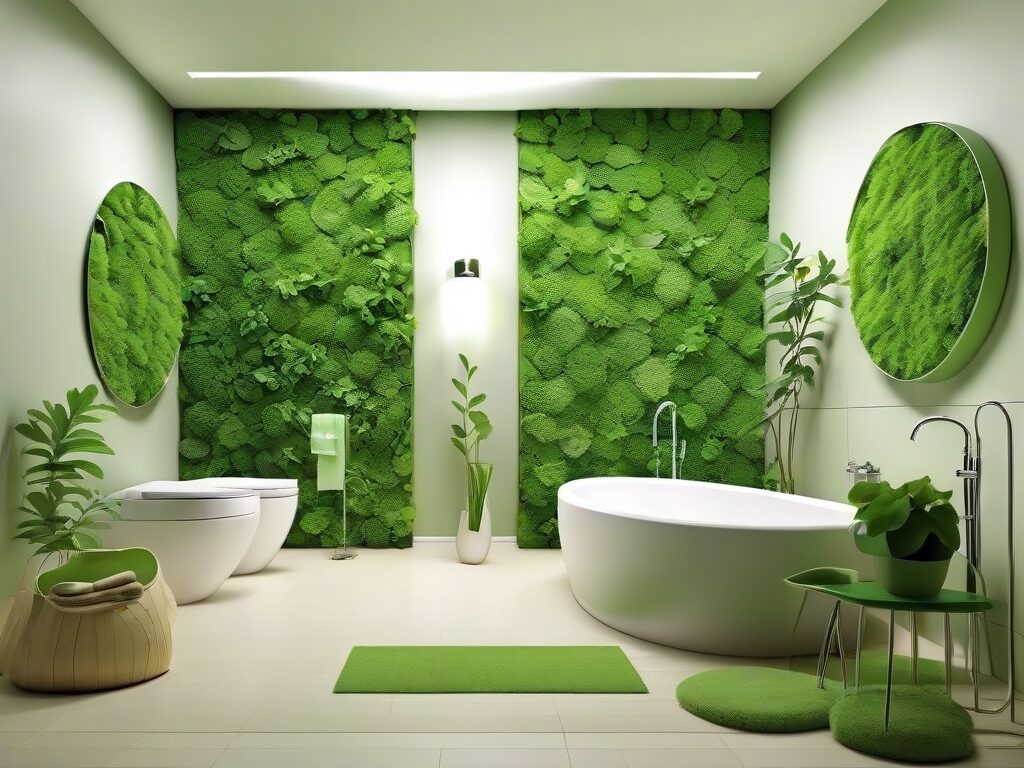
When it comes to creating an eco-friendly bathroom, the walls often get overlooked. However, opting for green wall treatments can significantly enhance your space’s sustainability while adding aesthetics and character.
A standout choice is biodegradable paint, which has gained popularity among eco-conscious homeowners. Unlike traditional paints that release harmful VOCs (volatile organic compounds), biodegradable paints are made from natural ingredients, promoting a healthier indoor environment. Brands like EarthSafe and AFM Safecoat offer vivid colors with minimal environmental impact, ensuring that you don’t have to compromise beauty for sustainability.
Another fantastic option making waves in sustainable home design is reclaimed wood panels. This innovative approach not only saves trees but also gives your bathroom a rustic charm that can transform an ordinary space into something extraordinary.
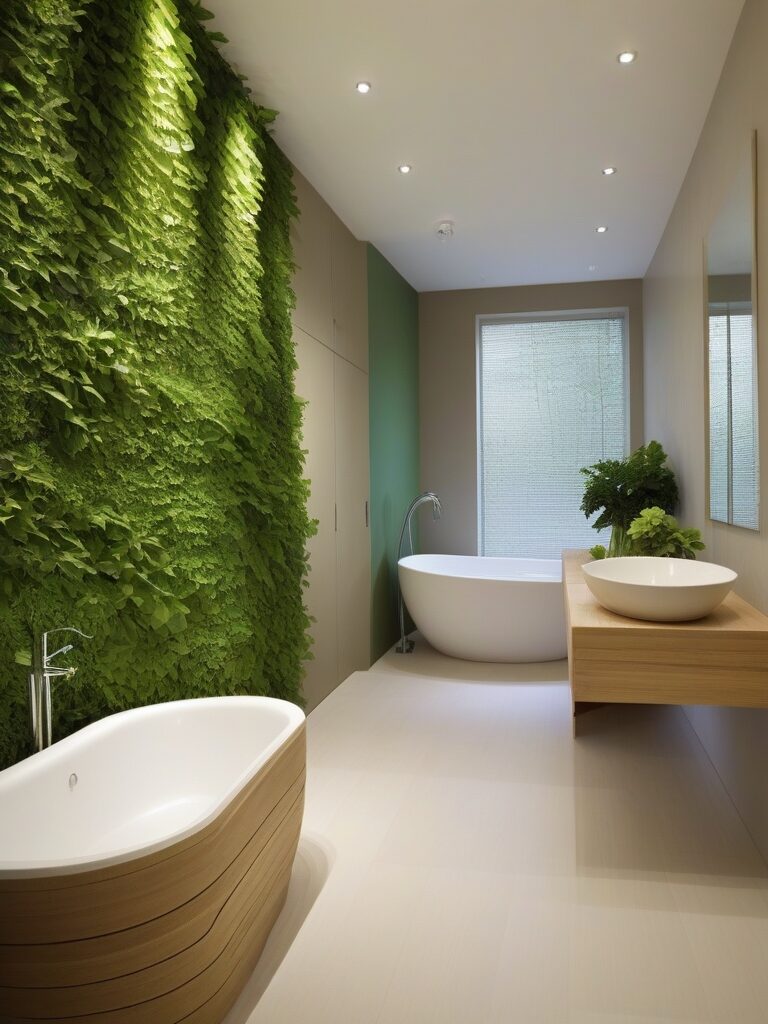
Many manufacturers source their wood from old barns, shipping pallets, or deconstructed homes—giving new life to materials that would otherwise end up in landfills.
For instance, using weathered barn wood as accent walls can create a warm earthy vibe reminiscent of nature’s splendor while contributing positively to the environment.
Consider wallpaper made from recycled materials if you’re looking for stylish yet low-impact décor solutions.
These wallpapers come in various designs and patterns—many of which are hard to differentiate from conventional paper options yet boast excellent eco-credentials.
Companies such as Graham & Brown produce wallpapers crafted from recycled post-consumer waste, providing a chic enhancement while keeping waste out of landfills.
With this choice, you’re not just sprucing up your bathroom; you’re telling a story about sustainable living and showing how beauty can coexist with responsibility.
Incorporating these green wall treatments allows you to revitalize your space creatively while staying true to eco-friendly principles.
Whether painting with safe finishes or dressing your walls in atmospheric reclaimed wood or chic recycled wallpaper, each option resonates with sustainability and functional aestheticism—a combination that’s sure to make a lasting impression on anyone who steps into your beautifully designed sanctuary.
Eco-Conscious Fixtures
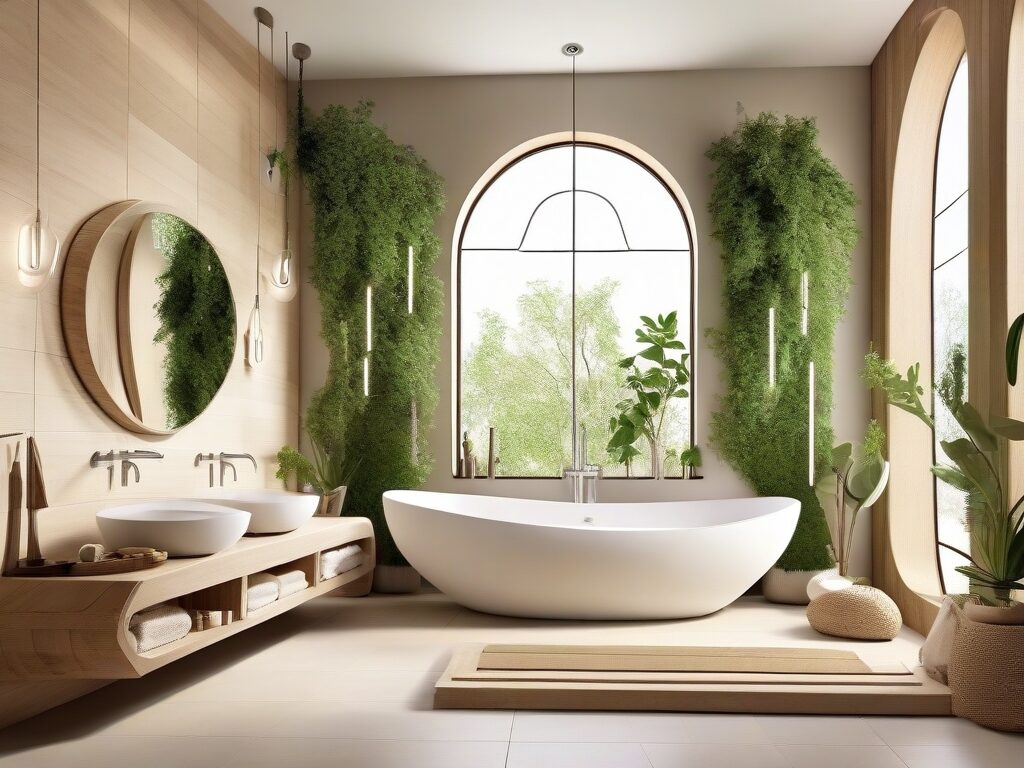
When it comes to creating a sustainable bathroom, choosing eco-conscious fixtures can make a significant impact on both your home’s efficiency and the environment. Low-flow toilets stand out as one of the most important upgrades you can make.
These modern marvels are designed to use much less water compared to traditional models—typically using only 1.28 gallons per flush or even less, rather than the standard 1.6 gallons.
For example, brands like Toto offer dual-flush systems that allow users to choose between a lighter flush for liquid waste and a fuller flush for solid waste. This feature not only conserves water but also encourages mindful usage among household members.
Lighting is another critical aspect of an eco-friendly bathroom, and LED lighting provides an energy-efficient solution that’s hard to ignore. Unlike incandescent bulbs, which waste 90% of their energy as heat, LED lights utilize about 75% less energy while lasting up to 25 times longer.
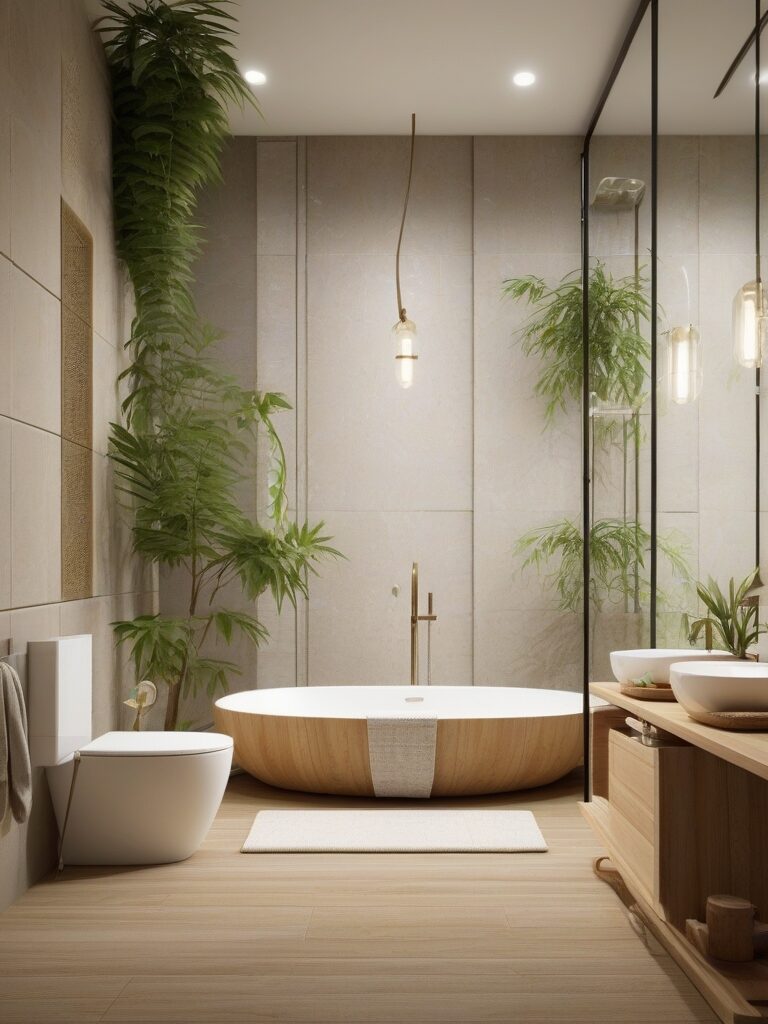
Imagine transforming your space with stylish LED sconces or dimmable fixtures that not only illuminate beautifully but also dramatically lower your electricity consumption.
With options ranging from soft white light for a relaxing ambiance to bright daylight bulbs that enhance task areas, there’s no reason not to switch to LEDs for an environmentally friendly glow.
Alongside toilets and lighting fixtures, faucet aerators represent an easy yet effective upgrade for reducing water usage in the bathroom sink without sacrificing performance.
These small devices attach effortlessly to existing faucets and introduce air into the flow of water, effectively maintaining pressure while reducing total volume used—often by nearly half! The result? You enjoy splashing water without feeling as though you’re skimping on cleanliness.
Brands such as WaterSense have developed aerators with smart technology that automatically adjusts flow based on necessity, making them a great fit for those who want both functionality and sustainability in their everyday lives.
By prioritizing these eco-conscious fixtures in your renovation plans or routine updates, you’re not just enhancing function but also paving the way toward more sustainable living practices in your home.
Each small choice contributes cumulatively towards reducing overall resource consumption—illustrating the profound positive impact of integrating environmental considerations into our most frequently used spaces.
Renovation Materials to Consider
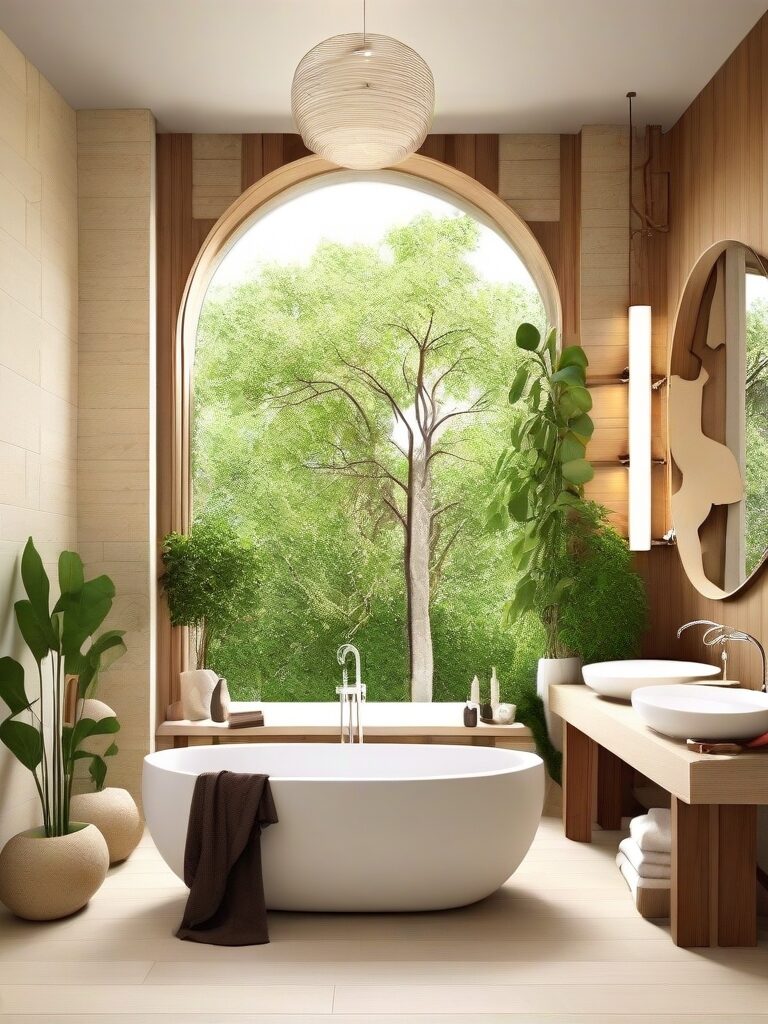
When embarking on a bathroom renovation, one of the most impactful decisions is selecting the right materials. Recycled glass countertops stand out as an exceptional option not only for their aesthetic appeal but also for their environmental benefits.
These vibrant surfaces are crafted from melted-down glass, often sourced from post-consumer products like bottles and jars.
The resulting patterns and colors create a stunning focal point in your bathroom while ensuring that waste is diverted from landfills. Imagine immersing yourself in a space where each glimmering surface tells a story of sustainability, reflecting a commitment to eco-friendly practices without compromising style.
Salvaged fixtures are another brilliant avenue to explore when redesigning your bathroom. By breathing new life into vintage items such as faucets, sinks, or even bathtubs, homeowners can infuse character and charm into their space while preserving our planet’s resources.
A clawfoot tub salvaged from an antiques shop not only serves as a functional centerpiece but also carries history within its porcelain walls.
Such fixtures often come with unique patinas and craftsmanship that modern replicas just can’t replicate. Plus, opting for reclaimed items reduces demand for new production, significantly lowering your project’s carbon footprint and aligning perfectly with sustainable living principles.
Another aspect worth considering is incorporating locally sourced materials into your renovation project. Supporting businesses from your community fosters economic growth while minimizing transportation emissions associated with long-distance sourcing.
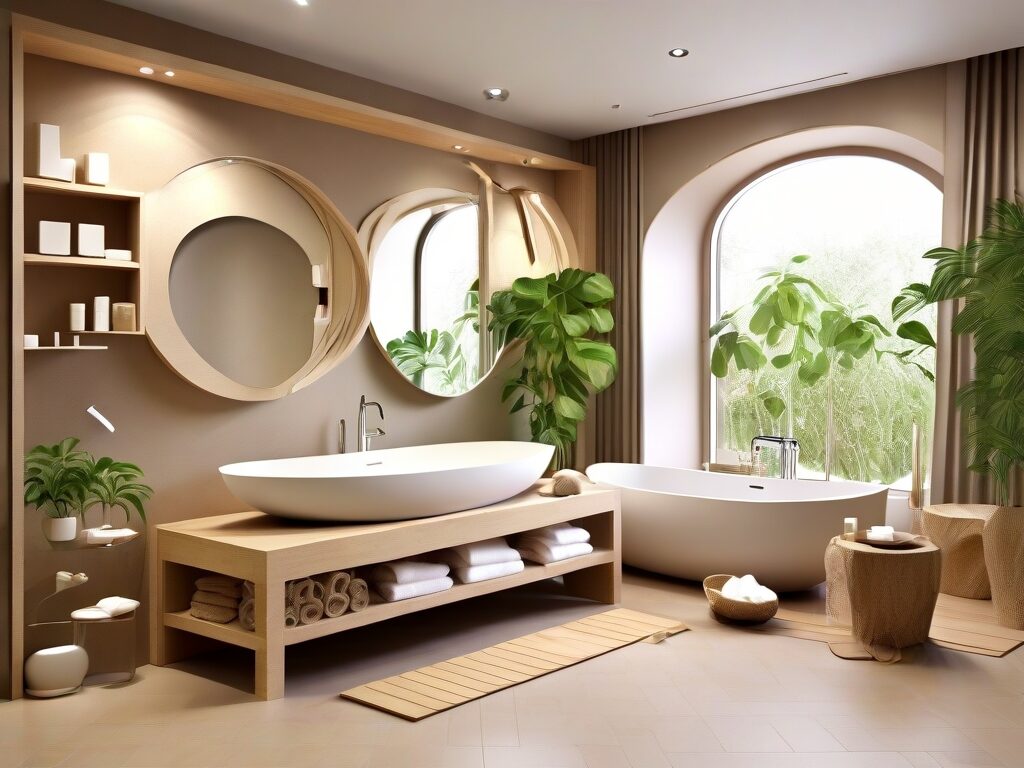
Whether it be ceramic tiles made by neighborhood artisans or wood harvested sustainably from local forests, these materials connect you more profoundly to your environment. Not only does this choice champion ethical consumption, but it also adds a personal touch—your bathroom can boast textures and designs created just down the road!
Furthermore, using local suppliers nurtures relationships and builds community resilience, reinforcing the essence of sustainability at its core.
Incorporating these innovative materials during renovations not only elevates the design aesthetics of your bathroom but leads you toward making meaningful contributions to environmental conservation efforts.
As you journey through this transformative process, remember that every small decision counts—from recycled glass countertops to salvaged fixtures—each provides a significant opportunity for sustainable living within our daily routines.
Eco-Friendly Textiles for the Bathroom
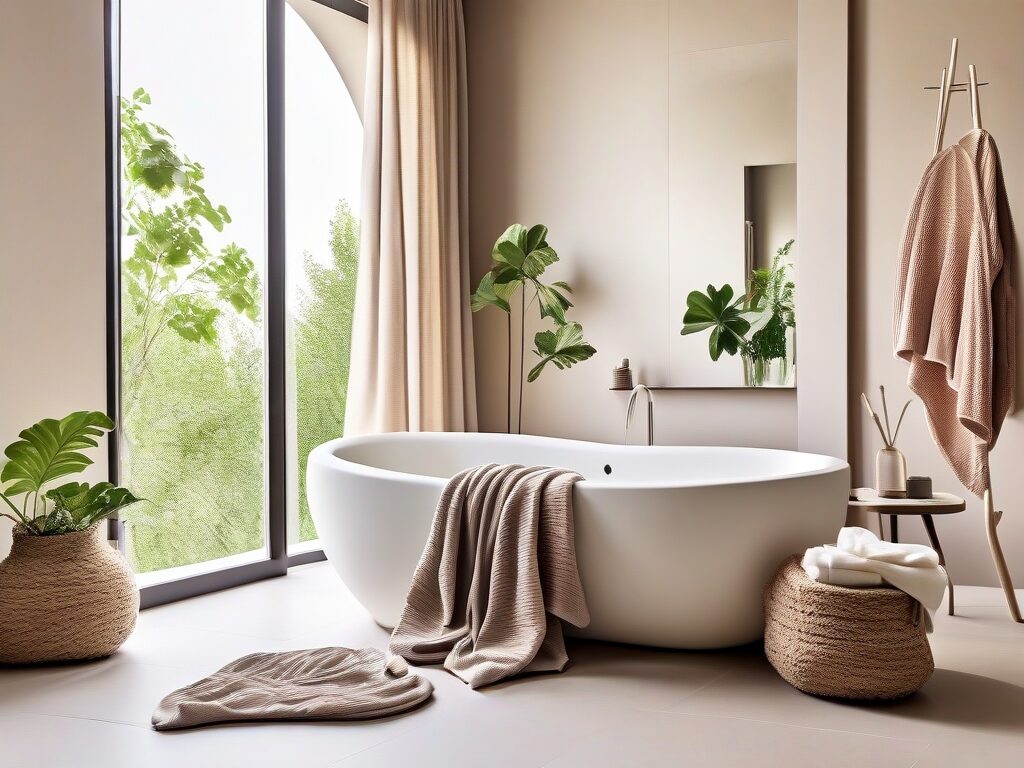
Transforming your bathroom into a sustainable sanctuary involves more than just selecting eco-friendly fixtures and surfaces; textiles play a significant role in enhancing the atmosphere while adhering to green principles.
Starting with organic cotton towels and rugs, these luxurious items are not only soft against the skin but also produced without harmful pesticides or fertilizers.
Imagine wrapping yourself in a plush towel made from cotton that has been grown sustainably—it’s like giving your body a gentle hug while minimizing environmental impact. Plus, keep an eye out for brands that emphasize fair trade practices, ensuring that both workers and earth are treated ethically.
Linen shower curtains present another stylish yet eco-conscious option. Crafted from natural fibers, linen is known for its remarkable breathability and moisture-wicking properties, making it less likely to harbor mold and mildew compared to synthetic alternatives.
Its unique texture adds an elegant touch to any bathroom decor while offering countless color and print options. Picture stepping out of your refreshing shower to be greeted by a textured linen curtain swaying gracefully in the breeze—a beautiful addition that marries form with function, keeping your space airy and inviting.
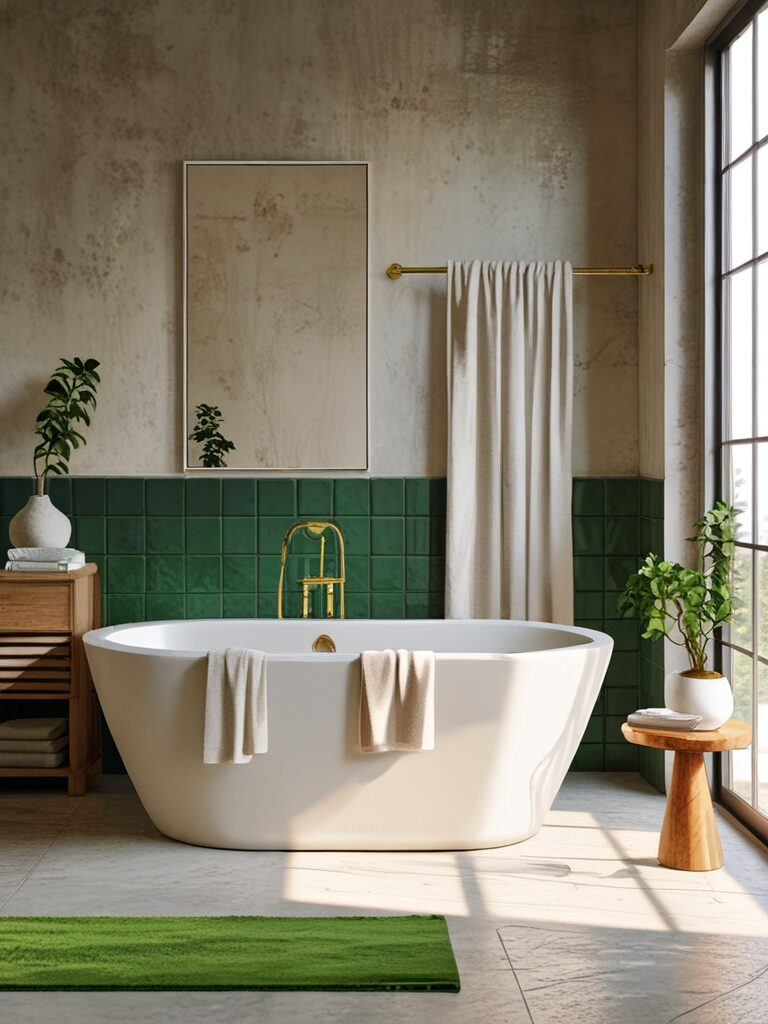
Hemp bath mats take sustainability to the next level with their durability and biodegradability. Hemp is fast-growing and incredibly resource-efficient—it requires far less water than traditional cotton crops.
These mats provide a chic accent while naturally absorbing moisture, reducing slipperiness on wet tiles after showers or baths. Plus, hemp’s inherent resistance to mold means you can enjoy both style and sanitation without compromising your commitment to eco-friendliness.
Elevating your bathroom décor has never felt so good when you know each choice supports sustainable farming practices.
By incorporating these eco-friendly textiles into your bathroom design, you’re not just opting for sustainable materials; you’re crafting a lifestyle that values both comfort and conscientious living.
With each small change—from lovely organic cotton towels to stylish hemp mats—you’re one step closer to curating a harmonious environment that reflects nature’s beauty while championing the health of our planet.
Innovative Green Accessories
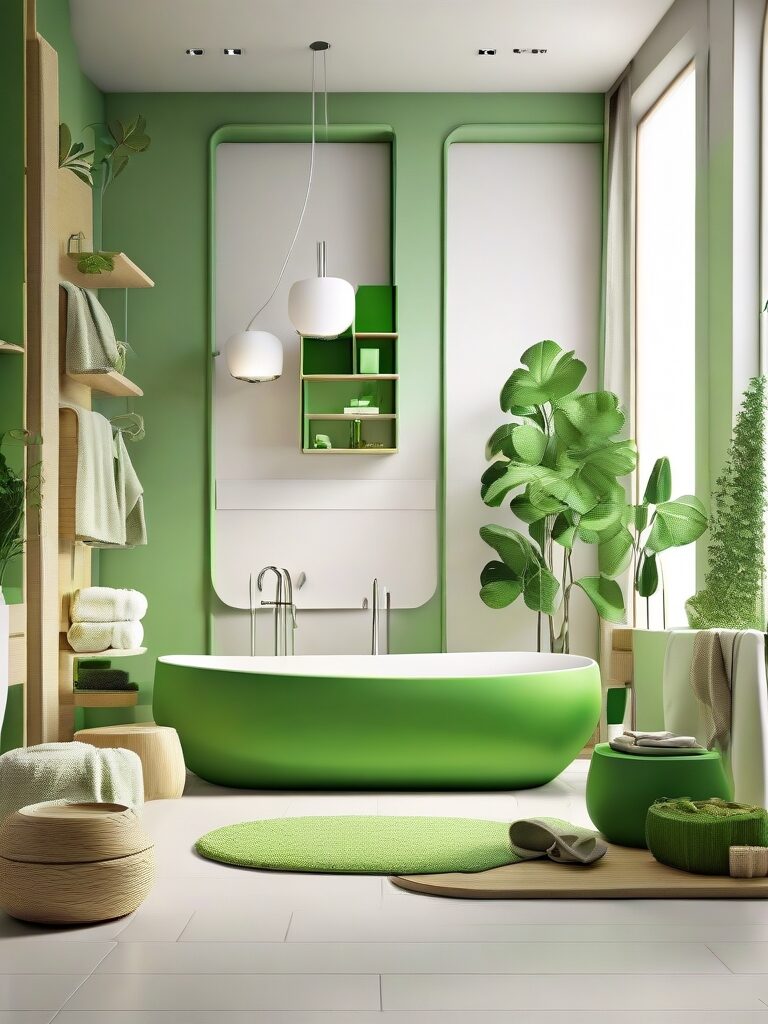
In an age where sustainability is not just a trend but a necessity, innovative green accessories are transforming the way we approach our daily routines.
One of the easiest yet impactful changes you can make in your bathroom is swapping out conventional plastic toothbrush holders for bamboo alternatives.
Not only do bamboo toothbrush holders have a sleek, modern aesthetic that enhances any decor, but they also come from one of the most renewable resources on the planet.
Bamboo grows rapidly and requires minimal resources to thrive, making it an eco-friendly choice that helps minimize our reliance on single-use plastics.
Another fantastic option to consider is biodegradable soap dishes. These accessories offer a perfect blend of function and sustainability, with options made from materials like wheat straw or palm leaves.
Unlike traditional plastic options that contribute to landfill waste, these biodegradable varieties naturally break down over time, leaving behind no harmful residues.
By introducing these into your bathroom routine, you’ll not only keep surfaces tidy but also consciously support environmentally responsible practices—all while enjoying products designed to stand up against water and humidity!
For those who enjoy makeup application, reusable makeup pads made from natural fabrics present an excellent sustainable solution that merges beauty with eco-friendliness.
Instead of disposable cotton pads that create unnecessary waste after every use, consider using washable alternatives crafted from bamboo or organic cotton blends.
Many brands now offer sets with cute designs that suit personal style while significantly reducing environmental impact over time. Endlessly reusable and super-soft on the skin, these pads redefine luxury by combining comfort with care for Mother Earth.
Ultimately, these innovative green accessories enhance your bathroom experience without sacrificing functionality or aesthetics.
Making small changes can lead to significant positive impacts—both in terms of personal wellness and ecological preservation—steering us toward a future where conscious living becomes second nature. Embrace these eco-friendly alternatives today; your morning routine will not only feel better but also contribute positively to the planet!
Creating a More Sustainable Bathroom Routine
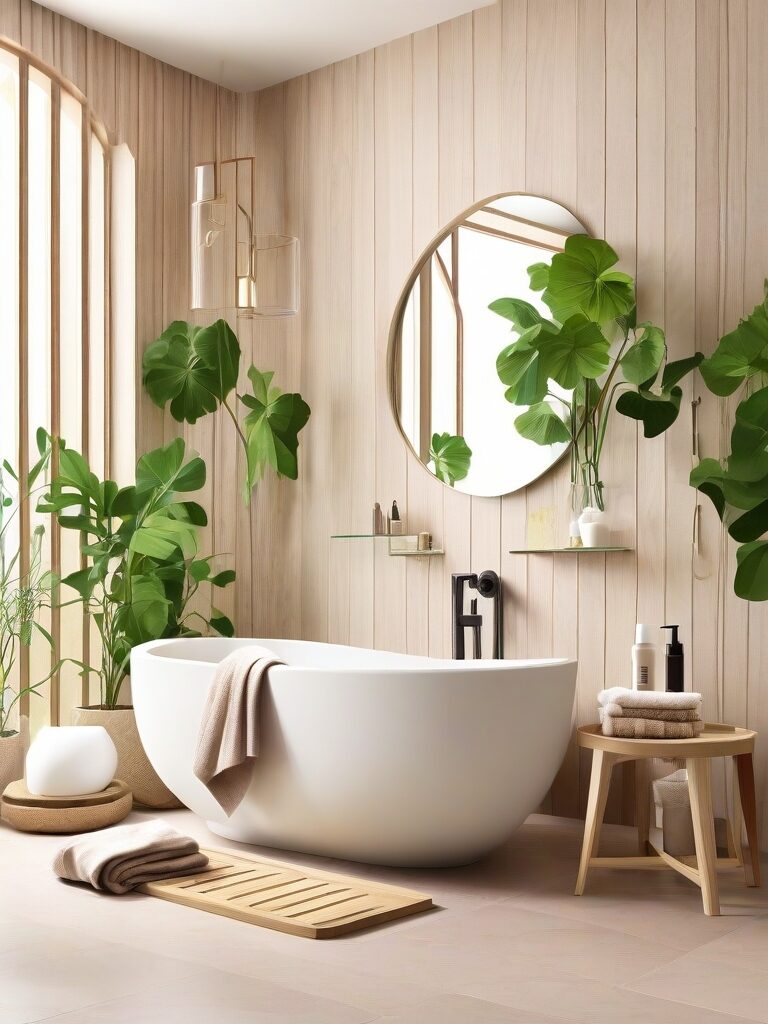
One of the simplest yet most effective ways to create a sustainable bathroom routine is to focus on reducing water usage, particularly during showers. Consider investing in a low-flow showerhead that can limit water usage without sacrificing pressure or comfort.
Simply switching your old showerhead for one that conserves water can save you thousands of gallons per year—resulting in lower utility bills and less strain on local water sources. Additionally, turning off the faucet while lathering up your body or shampooing can significantly reduce water waste.
Setting timers for shorter showers can also help instill this habit; many eco-conscious homeowners find that keeping shower times under five minutes transforms both their bathroom experience and their environmental impact.
In addition to mindful water usage, transforming your cleaning routine with DIY products made from natural ingredients will not only benefit the environment but also promote a healthier living space free from harsh chemicals.
For example, combining baking soda with vinegar creates an excellent natural cleaner for surfaces such as countertops and sinks. A simple mixture of castile soap, essential oils, and distilled water can serve as an all-purpose spray that disinfects while leaving behind a pleasant aroma.
Not only do these homemade alternatives minimize your exposure to toxic substances found in traditional cleaners, but they also reduce plastic waste commonly generated by store-bought products.
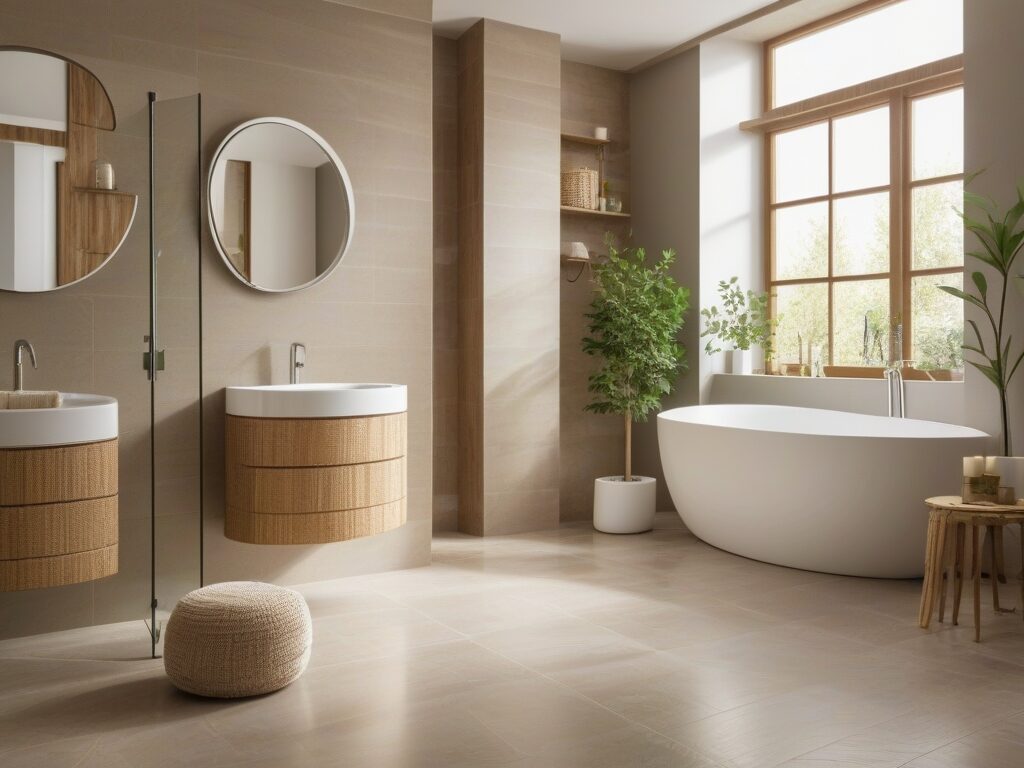
Lastly, choosing eco-friendly personal care items is an important aspect of establishing a sustainable bathroom routine. Opt for brands that prioritize sustainability through biodegradable packaging or use ethically sourced ingredients in their formulations.
For instance, look into shampoos and conditioners sold in bar form to eliminate plastic bottles, or switch to bamboo toothbrushes instead of traditional plastic options.
Many companies are now creating personal care lines made with organic materials free from synthetic chemicals—products like natural deodorants packaged in compostable tubes contribute to minimizing waste while supporting healthier skin and overall well-being.
By integrating these sustainable practices into your daily routine, you’ll foster an environment centered around conservation and responsibility without sacrificing comfort or style.
Every small change—from conscious consumption choices to the way you clean—helps you step closer toward a larger goal: nurturing our planet for generations to come while enjoying a healthy home atmosphere ideal for relaxation after long days.
Benefits of Going Eco-Friendly in Your Bathroom
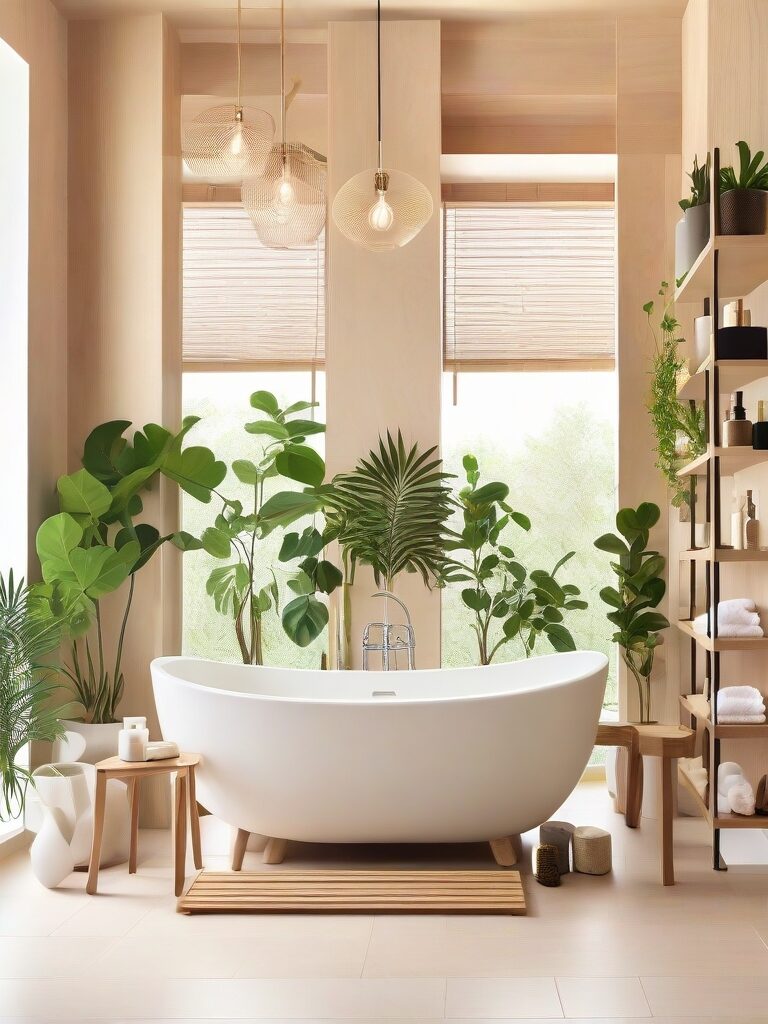
Making the shift towards eco-friendly bathroom materials not only enhances your home’s aesthetic and functionality but also significantly boosts its market value.
Homebuyers are increasingly seeking properties that reflect sustainable living practices, appreciating features like recycled glass countertops or low-flow toilets for their energy- and water-saving capabilities.
A bathroom that showcases these eco-conscious choices can set your home apart in a competitive market, offering a unique selling point that resonates with environmentally aware buyers.
The positive effects of embracing sustainable materials extend beyond personal benefit; they ripple out to create a brighter future for generations to come.
By reducing your carbon footprint and choosing products made from renewable resources, you’re not just transforming your bathroom – you’re participating in a global movement towards sustainability.
For instance, selecting reclaimed wood for cabinetry helps conserve forests while promoting recycling practices that keep waste out of landfills. This mindful approach today fosters an environment where future generations will inherit a viable planet.
Furthermore, incorporating non-toxic materials into your bathroom has direct health benefits for you and your family. Materials often found in conventional items release volatile organic compounds (VOCs), which can impair air quality and cause adverse health effects over time.
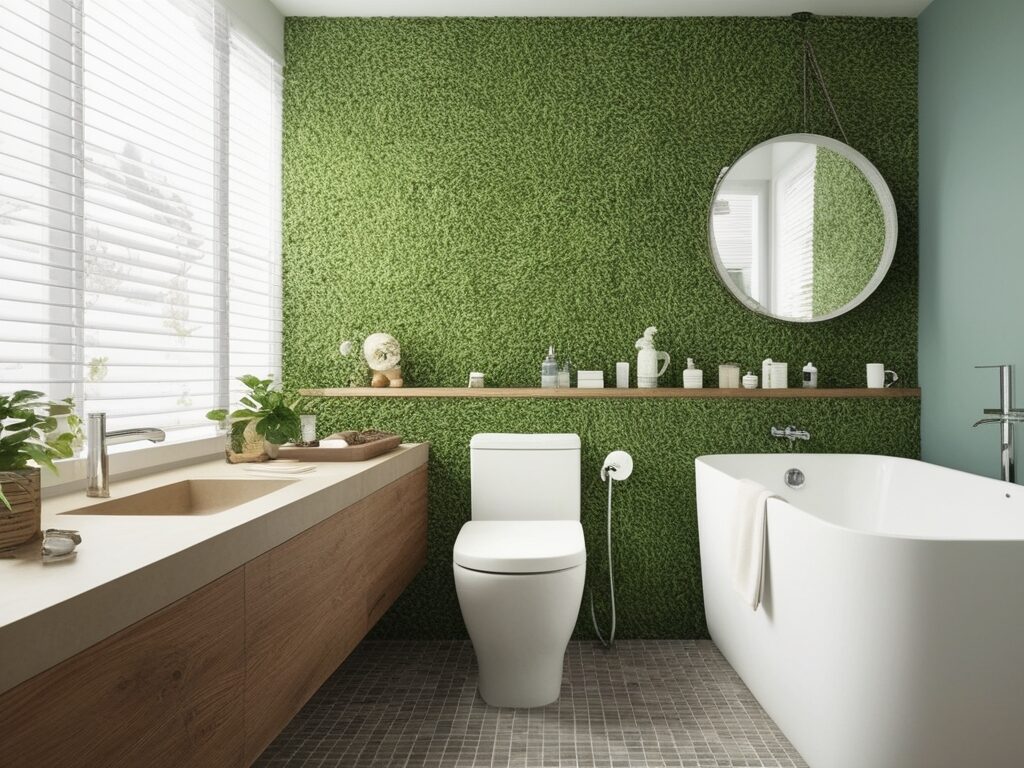
However, by opting for biodegradable paints or natural fiber textiles, like organic cotton towels or linen shower curtains, you contribute to creating a safer space free from harmful chemicals.
The tranquil experience of stepping into an eco-friendly bathroom isn’t merely aesthetic; it nurtures well-being by prioritizing clean air and sustainable comfort.
Ultimately, going green in the bathroom is about much more than aesthetics—it’s about making conscious choices that blend function with responsibility.
Each small change collectively contributes to a healthier household and promotes environmental stewardship while paving the way for innovative designs rooted in sustainability.
As homeowners recognize these profound benefits, it’s clear that converting to eco-friendly practices isn’t just beneficial—it’s imperative for the advancement of our communities and our world.
Embracing Sustainability in Your Bathroom
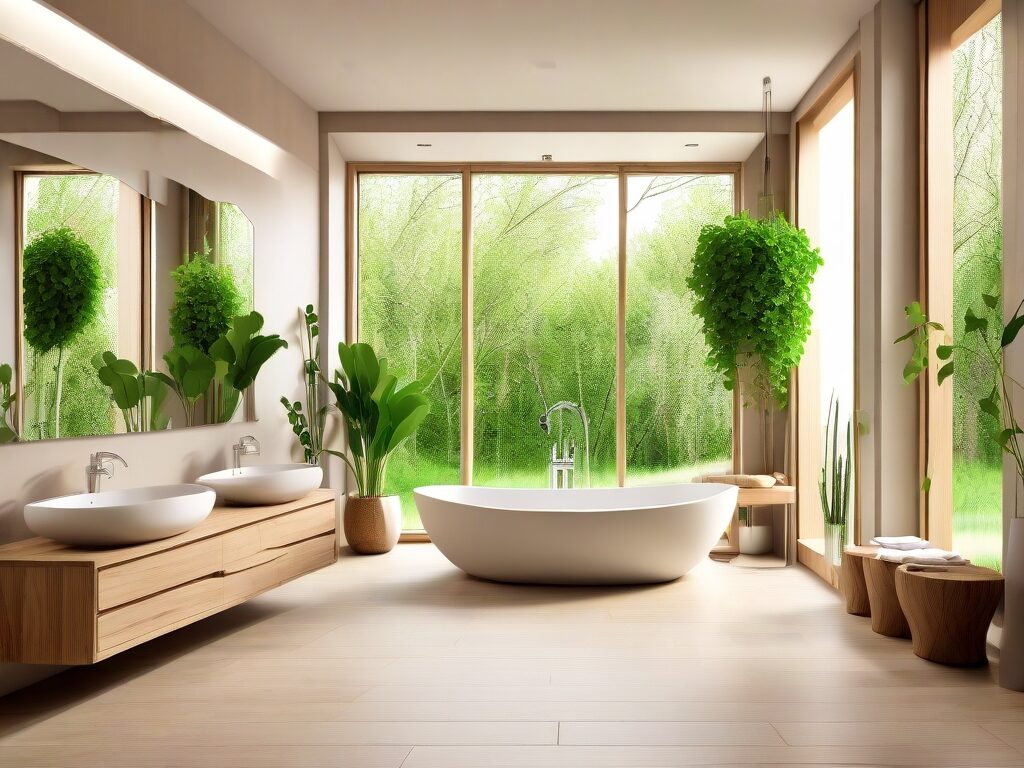
As we’ve explored throughout this article, your bathroom can be a showcase of eco-friendly materials and practices that not only benefit the environment but also enhance your home.
From sustainable flooring options like bamboo and cork to innovative fixtures such as low-flow toilets and energy-efficient lighting, there is no shortage of choices for creating a greener space.
The use of biodegradable paints, recycled tiles, and organic textiles all contribute to a healthier living environment while reducing your carbon footprint.
Starting small is key—consider replacing one item at a time or incorporating eco-friendly habits into your daily routine.
Whether it’s swapping out conventional cleaning supplies for DIY natural alternatives or choosing reusable accessories over disposable ones, every little effort counts.
By embracing these sustainable practices in your own bathroom, you set an inspiring example for family and friends, creating ripples of change that may encourage others to follow suit. Let your commitment to sustainability transform not just your space but also the future we share with generations to come.
Find Some Eco Bathroom Materials here
FAQs for Your Eco-Friendly Bathroom Materials ideas
Eco-friendly bathroom materials are sustainable options made from renewable resources, recycled products, or non-toxic substances that minimize environmental impact while providing durability and style.
Choosing eco-friendly materials not only reduces your carbon footprint but also promotes healthier indoor air quality and supports sustainable practices, making your sanctuary a guilt-free zone.
Absolutely! Look for fixtures made from recycled metals, bamboo, or low-VOC finishes that conserve water and energy without sacrificing style or functionality.
Start by selecting sustainably sourced materials, incorporating energy-efficient lighting, and using low-impact installation methods to keep waste to a minimum during renovations.
Yes! Consider tiles made from recycled glass, reclaimed wood, or natural stone sourced responsibly. They add beauty while being gentle on Mother Earth.
Maintain your eco-friendly choices by using non-toxic cleaning agents, avoiding harsh chemicals, and regularly checking for leaks to preserve both your materials and the planet!
Many eco-friendly materials are designed to be durable and long-lasting—often rivaling traditional options—so you can enjoy their benefits without frequent replacements.
Seek out specialty green building stores online or in your area; many retailers now offer dedicated sections for sustainable home products that make shopping easy and exciting!







